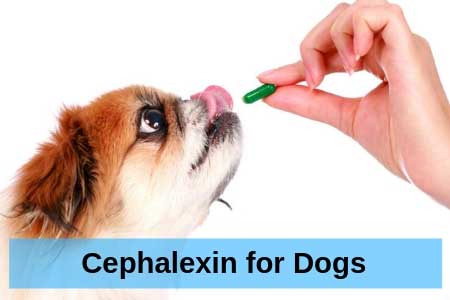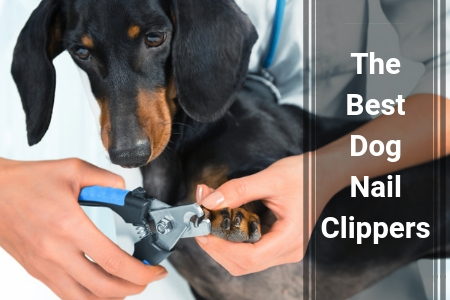If your dog is healthy, then it is indicative of a strong and robust immune system. Their immune system is responsible for eliminating all forms of infection and illnesses. Sometimes, however, their immune system becomes compromised and your dog falls sick.
When you think about it, it was bound to happen. Your dog loves spending time in the mud and dirt. He stays dirty most of the time. As such, it seems like a matter of time before he falls sick. With such close encounters with various forms of bacteria, how do you ensure that your dog recovers quickly and completely?
Easy! Modern antibiotics have made it easier for dog owners to keep their dogs in top shape. These modern antibiotics fight off these pathogens and ensure that your dog is healthy. While there may be a number of different medications available, Cephalexin seems to have won over most vets.
In case your vet prescribes the medication for your dog, it is important that you know what Cephalexin is and what it does for your pet. The drug is popular among dog owners as it eliminates a wide strain of bacteria with as few side effects as possible.
What Is Cephalexin for Dogs?
Cephalexin, also known as Cefalexin, is quite effective in eliminating gram-positive and gram-negative types of bacteria. Many experts such as those from the Merck Veterinary Manual explain that the cephalexin is extremely active against gram-positive bacteria. On the other hand, it is only moderately active against gram-negative bacteria.
It is basically a broad-spectrum antibiotic that is effective against a large number of strains. It is a first-generation drug derived from cephalosporin. You’ll be surprised to find that cephalexin is quite similar to penicillin antibiotics.
However, it might not be as effective as penicillin in some cases. For example, some anaerobic bacteria (i.e. bacteria that can survive without oxygen are not as affected by cephalexin as they are by penicillin).
The drug is available in various stores in the form of different names such as Rilexine, Keflex, Biocef, Sporidex, and Keftab. You can get it in the form of tablets, capsules, or even liquid.
It should be noted that cephalexin is a prescription drug that can only be used with a prescription. If your vet suspects that your dog is infected, they might run a few tests including blood tests to find out which bacteria strain is responsible. If they find it to be a specific bacterium that cephalexin can eliminate, only then will they prescribe the medicine.
How Does Cephalexin Work?
The drug belongs to a class of antibiotics called cephalosporin. Bacteria are living organisms that require nutrients such as proteins. Cephalexin works by damaging the production of protein in the cell wall of bacteria. This ultimately results in the death of the bacteria. This is why Cephalexin works great with gram-positive bacteria.
Also, the drug is only for bacterial infections and not intended to use against viral infections. When taken orally, it survives through the intestinal passages and easily enters the bloodstream. This way it easily reaches the target area.
Forms of Cephalexin for Dogs
Cephalexin for dogs is available in three different forms. These are:
Benefits of Cephalexin for Dogs
For dogs, cephalexin is used to treat a wide variety of bacterial infections that may occur in different parts of his body. This can often include bones, ears, skin, lungs and even urinary tract. Being a wide spectrum antibiotic, it can treat the following forms of bacteria:
However, you should note that the drug is not effective against all kinds of bacteria. Some bacteria such as Enterobacter and Pseudomonas Enterococci.
If vets diagnose your dog with various joint, ear, respiratory or urinary tracts, then Cephalexin is a quite valid prescription. Furthermore, most vets prescribe it to treat infection in the heart valve.
For instance, if your dog gets wounded or an abscess, then he might get inflicted with S. Aureus. These skin infections or hot spots are treated quite often with Cephalexin. However, most often, Cephalexin is often prescribed with other forms of topical ointments to help target the specific skin area.
The best part of the drug is that it is relatively inexpensive so anyone can afford it. Another thing to note is that you should always complete the course otherwise, your dog could contract a secondary infection or the bacteria can grow invulnerable to the medicine.

Common Ailments Cephalexin Treats
Cephalexin can be used to treat a number of infections and ailments in dogs. These are:
Cephalexin Dosage for Dogs
Cephalexin dosage for dogs depends on a number of different factors. These can include the age, the weight or size of the dog, and the type and area of infection. You should always consult your vet to know about the correct dosage for your particular dog since every dog has a different metabolic system. If given in excessive amounts, the drug is known to cause a number of side effects.
On the other hand, if given correctly, there is very little chance of any negative side effects. Another factor that affects the dosage is any pre-existing conditions or any medications he is already taking. This can result in various dangerous side effects.
General Dosage
Mostly, you can treat a Staphylococcus infection with 13.6 mg of the medication per pound of dog. The usual dosage should be given every 12 hours. However, a skin infection such as 10mg should be given every 8 hours per pound of dog. Also, if your dog has a respiratory infection, then we highly recommend a dose of 10-18 mg per pound every 8 hours.
The specific dosage depends on:
1. Weight
The general rule of thumb is that the dose should be higher as the body weight of your dog increases. For instance, a Labrador who weight about 50–70 lbs. normally receive 500 mg per dose.
2. Severity of Infection
Furthermore, the dose increases when the severity of the infection increases. For example, if your dog has contracted a soft tissue infection or his wound has been infected, then anywhere from 14–22 mg per pound should be given every 12 hours. The course takes about 7–12 days to complete.
As always, we recommend that you ask your vet for the proper dose.
How Often Should You Give Cephalexin to Your Dog?
Usually, your veterinarian will inform you on the proper use of the drug. It is important to follow the instructions properly. Typically, vets recommend a dose every 8 to 12 hours depending on the type of infection. They recommend a complete 7–10-day course.
In case you are late for a dose, do not double it the next time. Instead, if you’re only a little late, then just administer the dose. On the other hand, if you are late by a large margin, then it’s better to wait for the next dosage and simply administer that.
Only Use Cephalexin for Dogs by Prescription
Also, note that cephalexin for dogs is available only through your pets’ prescription. Do not self-diagnose or self-administer the drug. Consult your vet about the proper dosage or even if the cephalexin is good for your dog’s health.
So, why is it so important to give it to your dog through a prescription? Well, there are a bunch of different reasons such as:
1. Allergies
There’s a chance that your dog may be allergic to the drug.
2. Pre-existing Conditions
There are various pre-existing conditions that the drug can enhance.
3. Medications
Your dog may already be taking different medications that can react badly with the drug.
4. Bacterial Resistance
If you do not use the drug with proper doses or do not complete the full course, there is a high chance that the bacteria will develop resistance to the drug. Thus, the bacteria might relapse and the infection may be stronger than before.
Following the instructions and prescription from your vet is the best way you can guarantee your dog’s recovery.
Side Effects of Cephalexin for Dogs
Generally, Cephalexin is a safe drug for dogs and human alike. Most often, your vet will prescribe it for a week or two. This won’t harm your dog at all. However, before you administer the drug it is important to check any pre-existing conditions or if the dog is nursing or pregnant.
There can be a number of side effects to cephalexin if you administer it improperly.
1. Nausea and Vomiting
One of the most common side effects of the drug is that it can cause nausea and vomiting in dogs. It may be a result of allergies to the drug or because of an overdose. It is important to check the dosage instructions on the bottle and those given by the vet. Check our instructions on the proper dosage for dogs above.
2. Diarrhea and Pain
Another side effect due to overdose is diarrhea and stomach pains. Since the drug is quite heavy, it is important that you administer it after meals or with milk. This ensures that the drug does not affect the dog’s stomach too much. However, if diarrhea continues, experts recommend that you stop the medication and look for lighter alternatives. Some dogs even suffer from a loss of appetite.
3. Allergic Reaction
Check if your dog is allergic to penicillin or penicillium molds. Since Cephalexin uses similar derivation methods, there’s a high chance that your dog will be allergic to this medication as well. If your dog is allergic to the medicine, then he might show the following symptoms:
4. Serious Diseases
The drug, if administered improperly, can lead to serious complications as well. If used extensively, it can reduce the white cell count, leaving your dog impervious to diseases. Other consequences include kidney necrosis, interstitial nephritis, and hepatitis, etc.
5. Behavioral Side Effects
Your dog may also exhibit a wide variety of behavioral symptoms including irritation or hyperactivity. He might not breathe well and you’ll often find him panting. Another change you might notice is that your dog may drool excessively.

Precautions Regarding Cephalexin for Dogs
Before administering the drug to your dog, we highly recommend that you take the following precautions.
How Should I Give My Dog Cephalexin?
Although simply giving your dog the capsule is just fine, you should administer it with food. You can give it without food; however, it can cause complications such an upset stomach and diarrhea. Give your dog Cephalexin with meals to reduce any side effects.
On the other hand, the food doesn’t have to be a full meal. A few bites in which you can wrap the tablet around would be fine. This ensures that your dog can easily gulp the tablet down without making a scene.
When Does Cephalexin Not Work for Dogs?
1. Certain Bacteria
In certain cases, a broad spectrum of medicine such as Cephalexin can often fail. This is because it cannot effectively target that bacteria. This can include bacteria such as the Enterobacter. This form of bacteria can often cause eye infections, UTIs and skin infections. Using the drug, in this case, will not help the situation.
2. Viruses
Also, note that the drug is ineffective against viruses and it will not treat any viral infections.
3. Fungi
In addition, it is ineffective against any fungal infections such as ringworm or Athlete’s foot.
The only way you can find out the cause of your dog’s affliction is by testing his blood or skin. Then when it’s clear that the drug can effectively eliminate the cause, the vet will prescribe the drug.
Other Alternatives to Cephalexin for Dogs
There are various other alternatives to the drug for dogs. A common alternative is penicillin as it works in a similar way. However, you can use amoxicillin as well.
In some cases, dogs do not require an antibiotic or drug at all especially if it’s a skin infection. Some vets put a compress near the location to increase the blood flow. The blood brings T-cells to the location for effective healing.
Final Thoughts
All in all, Cephalexin is an important antibiotic that can help your dog fight off a large number of bacterial infections. We highly recommend that you consult with your vet for various reasons. First, it is important to find out the cause of the infection and whether the drug will be effective against it. Second, you need to ask your vet for the appropriate dosage and course time.
Lastly, you cannot get the medicine without the prescription of your vet. It is important that you follow the dosage instructions and complete the full course. Otherwise, your pet can experience a number of side effects ranging from rashes to kidney and liver diseases. Also, look for pre-existing conditions and medications and whether the drug can worsen them.
In most cases, you’ll find that the drug is effective and your dog will be happy and healthy in no time. In case, it isn’t or it shows several side effects such as diarrhea, vomiting, lethargy, and so on, immediately contact your vet.






